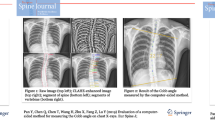Abstract
Scoliosis has a detrimental effect on lung function. Since spine radiographs are commonly used for monitoring the progress of the disorder, semi-automated lung field segmentation from scoliosis radiographs is a primary step in further automation and processing. Existing lung field segmentation algorithms have been developed specifically for chest radiographs, which differ from spine radiographs in imaging aspects and appearance. The present work uses intensity profile processing followed by the optimization of a flexible polynomial template developed without prior training data. Right and left lungs are processed separately due to the presence of the cardiac shadow and differences in lung shape. Intensity profile processing is based on identification of the maxima and minima in segments of the horizontal profiles or their derivatives. The polynomial template represents an implicit shape model defined separately for each lung using three initial points chosen by the user. Thus, a unique template is generated for each case. The algorithm was tested on six sets of patient radiographs varying in severity of scoliosis and image quality. The proposed method successfully detects overlapping regions of the lung and the spine and has high accuracy even for severely deformed lungs.





Similar content being viewed by others
References
Tsiligiannis, T., & Grivas, T. (2012). Pulmonary function in children with idiopathic scoliosis. Scoliosis, 7, 7.
Trovato, A., Komeili, A., Westover, L., Parent, E., Moreau, M., & Adeeb, S. (2014). Review: Examination of breast asymmetry associated with adolescent idiopathic scoliosis using surface topography methods. Journal of Medical and Biological Engineering, 34, 612–617.
van Ginneken, B., Stegmann, M. B., & Loog, M. (2006). Segmentation of anatomical structures in chest radiographs using supervised methods: A comparative study on a public database. Medical Image Analysis, 10, 19–40.
Grenier, S., Parent, S., & Cheriet, F. (2013). Personalized 3D reconstruction of the rib cage for clinical assessment of trunk deformities. Medical Engineering and Physics, 35, 1651–1658.
Jolivet, E., Sandoz, B., Laporte, S., Mitton, D., & Skalli, W. (2010). Fast 3D reconstruction of the rib cage from biplanar radiographs. Medical and Biological Engineering and Computing, 48, 821–828.
Humbert, L., de Guise, J. A., Aubert, B., Godbout, B., & Skalli, W. (2009). 3D reconstruction of the spine from biplanar X-rays using parametric models based on transversal and longitudinal inferences. Medical Engineering and Physics, 31, 681–687.
Bertrand, S., Laporte, S., Parent, S., Skalli, W., & Mitton, D. (2008). Three-dimensional reconstruction of the rib cage from biplanar radiography. IRBM, 29, 278–286.
Iakovidis, D. K., Savelonas, M. A., & Papamichalis, G. (2009). Robust model-based detection of the lung field boundaries in portable chest radiographs supported by selective thresholding. Measurement Science and Technology, 20, 104019.
Dawoud, A. (2011). Lung segmentation in chest radiographs by fusing shape information in iterative thresholding. IET Computer Vision, 5, 185–190.
Jaeger, S., Karargyris, A., Candemir, S., Folio, L., Siegelman, J., Callaghan, F., et al. (2014). Automatic tuberculosis screening using chest radiographs. IEEE Transactions on Medical Imaging, 33, 233–245.
Xu, X. W., & Doi, K. (1995). Image feature analysis for computer-aided diagnosis: Accurate determination of ribcage boundary in chest radiographs. Medical Physics, 22, 617–626.
Xu, X. W., & Doi, K. (1996). Image feature analysis for computer-aided diagnosis: Detection of right and left hemidiaphragm edges and delineation of lung field in chest radiographs. Medical Physics, 23, 1613–1624.
McNitt-Gray, M. F., Huang, H. K., & Sayre, J. W. (1995). Feature selection in the pattern classification problem of digital chest radiograph segmentation. IEEE Transactions on Medical Imaging, 14, 537–547.
Annangi, P., Thiruvenkadam, S., Raja, A., Xu, H., Sun, X. S. X., & Mao, L. M. L. (2010). A region based active contour method for X-ray lung segmentation using prior shape and low level features. In Proceedings of the international symposium on biomedical imaging, 2010 (pp. 892–895).
van Ginneken, B., Katsuragawa, S., ter Haar Romeny, B. M., Doi, K., & Viergever, M. (2002). Automatic detection of abnormalities in chest radiographs using local texture analysis. IEEE Transactions on Medical Imaging, 21, 139–149.
Cootes, T. F., Edwards, G. J., & Taylor, C. J. (2001). Active appearance models. IEEE Transactions on Pattern Analysis and Machine Intelligence, 23, 681–685.
MATLAB and global optimization toolbox release 2015a. The Mathworks, Inc. (2015). http://in.mathworks.com/help/gads/patternsearch.html.
Iakovidis, D., & Papamichalis, G. (2008). Automatic segmentation of the lung fields in portable chest radiographs based on Bézier interpolation of salient control points. Proceedings of the International Workshop on Imaging Systems and Techniques, 217139, 82–87.
Paul, J. L., Levine, M. D., Fraser, R. G., & Laszlo, C. A. (1974). The measurement of total lung capacity based on a computer analysis of anterior and lateral radiographic chest images. IEEE Transactions on Biomedical Engineering, 21, 444–451.
Pietka, E. (1994). Lung segmentation in digital radiographs. Journal of Digital Imaging, 7, 79–84.
Armato, S. G., Giger, M. L., & MacMahon, H. (1998). Automated lung segmentation in digitized posteroanterior chest radiographs. Academic Radiology, 5, 245–255.
Author information
Authors and Affiliations
Corresponding author
Ethics declarations
Conflict of interest
None declared.
Rights and permissions
About this article
Cite this article
Deshpande, R., Ramalingam, R.E., Chatzistergos, P. et al. Semi-automated Lung Field Segmentation in Scoliosis Radiographs: An Exploratory Study. J. Med. Biol. Eng. 35, 608–616 (2015). https://doi.org/10.1007/s40846-015-0084-x
Received:
Accepted:
Published:
Issue Date:
DOI: https://doi.org/10.1007/s40846-015-0084-x




